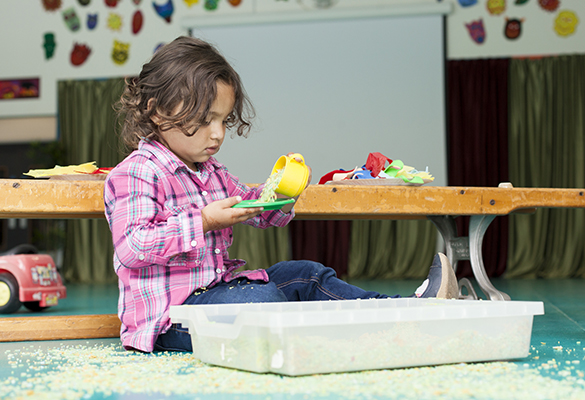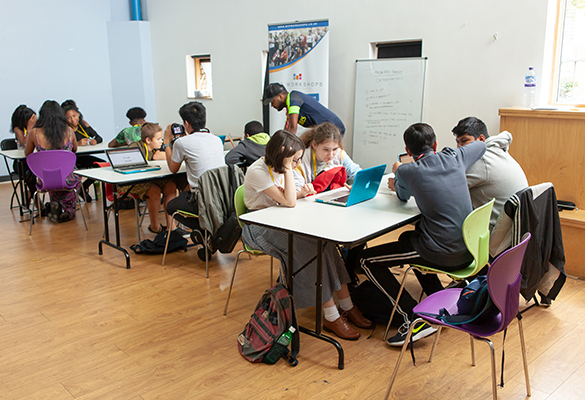The Hub
Child Sexual Exploitation
Child Sexual Exploitation (CSE) is a form of sexual abuse and can take place in various different forms. Read on for support and advice for raising awareness of CSE or supporting children who have been sexually abused in your schools.
Child Exploitation and Online Protection
New #SendMeAPic resources
This week CEOP published a new learning resource, accredited by the PHSE Association, for use with 12 to14-year-olds to explore issues related to nude and explicit image sharing. Young people have been involved in the design of this resource, which includes lesson plans, short videos and factsheets.
How to Identify CSE
The statutory definition of CSE is as follows:
"Child sexual exploitation is a form of child sexual abuse. It occurs where an individual or group takes advantage of an imbalance of power to coerce, manipulate or deceive a child or young person under the age of 18 into sexual activity (a) in exchange for something the victim needs or wants, and/or (b) for the financial advantage or increased status of the perpetrator or facilitator. The victim may have been sexually exploited even if the sexual activity appears consensual. Child sexual exploitation does not always involve physical contact; it can also occur through the use of technology."
CSE can take place in various different forms and recent high profile reports and enquiries (e.g. Rotherham and Rochdale) have focused largely on one form of CSE where young women were groomed by older men and exploited on an organised level.
It is important to bear in mind that children can also be exploited by their peers, and by family members. Young women affected by/involved in gangs are also at significant risk of being sexually exploited.
- List of vulnerability factors and risk indicators
- DfE's guidance "Child sexual exploitation: definition and guide for practitioners"
CSE can be difficult to identify as children often do not recognise that they are being sexually exploited, many children will have been subjected to a grooming process whereby the person exploiting them has employed various techniques to make the child believe that they are consenting to the situation.
Children who are experiencing CSE may also have a lack of distrust in authority figures or may display behavioural issues at school and all efforts should be made by professionals to explore the reasons why the child is displaying such behaviours.
The Office of the Children's Commissioner identified in their enquiry into CSE that children at risk of/experiencing CSE are often described as "putting themselves at risk", "prostituting themselves" and "promiscuous", these terms suggest the child is complicit in and/or to blame for the abuse they experience and should be avoided.
It has been acknowledged by the Office of the Children's Commissioner, LSCB and Ofsted that this language and prevailing attitudes have led to systematic failings to protect and safeguard children at risk of child sexual exploitation.
What to do if you are concerned that a child is at risk of/experiencing CSE
If as a professional you believe that a child has suffered or is likely to suffer significant harm or have any other child protection concerns do not delay and contact the Multi Agency Safeguarding Hub (MASH) team to discuss your concerns, and follow in writing on the Multi Agency Referral Form (MARF).
Telephone: 020 8496 2310 (Monday - Thursday 9am-5.15pm and Fri 9am-5pm)
Out of Hours Tel: 020 8496 3000
Fax: 020 8496 2313
Email: MASHrequests@walthamforest.gov.uk
There are several local specialist services who can provide advice and guidance to professionals and also direct support to children where there are concerns about CSE.
How Schools can raise awareness of of CSE.
Responding to Sexting and Managing Sexting Incidents
The websites and documents below offer advice on responding to sexting incidents in your schools or colleges.
- The UK Council for Child Internet Safety (UKCCIS) has produced advice for schools and colleges on responding to incidents of 'sexting.' The advice aims to support them in tackling the range of issues which these incidents present including responding to disclosures, handling devices and imagery, risk assessing situations and involving other agencies. The advice also contains information about preventative education, working with parents and reporting imagery to providers.
- The resources area of the Thinkuknow website has additional support around how to respond to incidences of sexting in schools.
- UK Safer Internet Centre has support about responding to sexting and managing sexting incidents, including this managing sexting info-graphic.


Useful CSE Resources for Schools
If you would like to learn more about CSE then you can read the research and guides below. Further down the page you will find useful downloads to help with lesson planning around CSE.
- Reflections on child sexual exploitation: a report by Louise Casey CB
- Sexual violence and the law: a young person's guide
- So you got naked online
- Sexual exploitation: sex, secrets and lies. Your guide
- MAP (multi-agency planning) and MASE (multi-agency sexual exploitation) meetings guidance
- The London Child Sexual Exploitation Operating Protocol, 2nd Edition - March 2015
Resources for Parents
It is important for parents/carers to be informed about CSE and in cases where children are at risk of/experiencing CSE this information should be shared with the parents/carers and they should be included in the safety planning where possible.
In the same way that children can be groomed by those exploiting them, parents/carers can also be groomed or coerced into allowing the exploiters access to their child. Research and high profile serious case reviews have shown that family members of children experiencing CSE can often be threatened, coerced or intimidated by the exploiters in order for them to have more power and control over the child. Parents and carers should not be blamed for the situation that their child is in, rather supported to be more informed about CSE and enabled to respond to the risks that their child is facing.
There are specific services for parents who may have a child at risk of/experiencing CSE.
PACE are a national charity who can provide practical and emotional over-the-phone support to parents as well as providing advice and guidance to professionals.
Lesson resources
NSPCC Underwear rule resources
Ks1 & 2 A variety of resources aimed at protecting children from harm and abuse.
View more infoNSPCC "I saw your willy"
KS1 & 2 - Short video (1 min) highlighting the dangers of sharing sexually explicit images
View videoExpect Respect Toolkit
KS1 & 2 - Not CSE specific - Focus on prevention of domestic and sexual violence. Lesson plans for reception to Y6.
DownloadThinkuknow resources
Variety of resources available around online safety for different age groups.
View more infoSafety Plan for Young People
Emergency safety plan included, with contacts and spaces for yp to fill in.
DownloadGrowing Up with Yasmin and Tom
Free sample lesson plans on, Parts of the body, Photos of myself online and Social networking
Download resourcesWarning Signs & Vulnerabilities Checklist (CSE)
Checklist from Office of the Children's Commissioner. Would farm part of staff training.
DownloadSpot the Signs professionals leaflet (Barnardo's)
Barnardo's leaflet on spotting the signs of CSE. Would form part of staff training in addition to checklist above.
DownloadFriends or Foe
Lesson plans targeted at Secondary aged pupils but could be adapted for Primary context.
DownloadKS2 Safe Touch Lesson Plans
Includes boundaries, personal risky situations and identifying 'safe people'.
DownloadNorth Somerset Primary Healthy Relationships Guidance
Includes units of work for KS1 and KS2. Some useful resources including boy/girl outlines.
DownloadRelationships, Sexual Health and Parenthood resource
For young people with ASD. Relevant and useful for pupils with ASD, although targeted more at Secondary pupils
Download